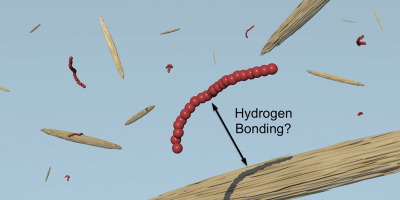Current Opinion in Colloid & Interface Science ( IF 7.9 ) Pub Date : 2017-03-18 , DOI: 10.1016/j.cocis.2017.03.005 Michael S. Reid , Marco Villalobos , Emily D. Cranston

|
A piqued interest in nanocellulose has recently arisen due to the growing need to use sustainable and renewable materials in place of those that are derived from petrochemical resources. Although current commercial uses of nanocellulose remain limited, research over the past two decades demonstrates numerous applications including reinforcing agents in polymer and cement composites, coatings, foams, gels, tissue scaffolds, and rheological modifiers, amongst others. Because of the hydrophilic nature of nanocellulose many of the potential uses will likely be in water-based formulations or employ water-based processing methods. Thus understanding the interactions between nanocellulose and water-soluble polymers is critical. Although polyelectrolyte adsorption to cellulose is well understood, adsorption of non-ionic polymers is less clear, with hydrogen bonding often cited as a governing factor. Recent work suggests that in fact hydrogen bonding does not play a significant role in nanocellulose systems, and that non-ionic polymer adsorption is largely entropically driven. Herein we review current literature that investigates non-ionic polymer adsorption to cellulose nanocrystals (CNCs) and draw upon previous papermaking research to better understand the mechanisms involved. Additionally we analyze recent work that compares the adsorption of polyethylene glycol (PEG) to CNCs and fumed silica that provides further insight into this phenomenon. Our findings, along with current literature, suggest that hydrogen bonding does not significantly impact polymer adsorption in aqueous media despite reports to the contrary.
中文翻译:

氢键在非离子聚合物吸附到纤维素纳米晶体和二氧化硅胶体中的作用
由于人们越来越需要使用可持续的和可再生的材料来代替源自石油化学资源的材料,因此人们对纳米纤维素产生了浓厚的兴趣。尽管目前纳米纤维素的商业用途仍然受到限制,但过去二十年的研究表明,其用途广泛,包括聚合物和水泥复合材料中的增强剂,涂料,泡沫,凝胶,组织支架和流变改性剂等。由于纳米纤维素的亲水性,许多潜在的用途可能是在水基制剂中或采用水基加工方法。因此,了解纳米纤维素与水溶性聚合物之间的相互作用至关重要。尽管聚电解质对纤维素的吸附已广为人知,但非离子聚合物的吸附尚不十分清楚,氢键常被认为是决定性因素。最近的工作表明,实际上氢键在纳米纤维素系统中没有发挥重要作用,并且非离子聚合物的吸附很大程度上受熵驱动。本文中,我们回顾了研究非离子聚合物对纤维素纳米晶体(CNC)吸附的现有文献,并借鉴了以前的造纸研究以更好地理解所涉及的机理。此外,我们分析了最近的工作,该工作比较了聚乙二醇(PEG)对CNCs和气相二氧化硅的吸附,从而提供了对该现象的进一步了解。我们的发现以及现有文献表明,尽管有相反的报道,氢键并不会显着影响聚合物在水性介质中的吸附。最近的工作表明,实际上氢键在纳米纤维素系统中没有发挥重要作用,并且非离子聚合物的吸附很大程度上受熵驱动。本文中,我们回顾了研究非离子聚合物对纤维素纳米晶体(CNC)吸附的现有文献,并借鉴了以前的造纸研究以更好地理解所涉及的机理。此外,我们分析了最近的工作,该工作比较了聚乙二醇(PEG)对CNCs和气相二氧化硅的吸附,从而提供了对该现象的进一步了解。我们的发现以及现有文献表明,尽管有相反的报道,氢键并不会显着影响聚合物在水性介质中的吸附。最近的工作表明,实际上氢键在纳米纤维素系统中没有发挥重要作用,并且非离子聚合物的吸附很大程度上受熵驱动。本文中,我们回顾了研究非离子聚合物对纤维素纳米晶体(CNC)吸附的现有文献,并借鉴了以前的造纸研究以更好地理解所涉及的机理。此外,我们分析了最近的工作,该工作比较了聚乙二醇(PEG)对CNCs和气相二氧化硅的吸附,从而提供了对该现象的进一步了解。我们的发现以及现有文献表明,尽管有相反的报道,氢键并不会显着影响聚合物在水性介质中的吸附。非离子聚合物的吸附主要是由熵驱动的。本文中,我们回顾了研究非离子聚合物对纤维素纳米晶体(CNC)吸附的现有文献,并借鉴了以前的造纸研究以更好地理解所涉及的机理。此外,我们分析了最近的工作,该工作比较了聚乙二醇(PEG)对CNCs和气相二氧化硅的吸附,从而提供了对该现象的进一步了解。我们的发现以及现有文献表明,尽管有相反的报道,氢键并不会显着影响聚合物在水性介质中的吸附。非离子聚合物的吸附主要是由熵驱动的。本文中,我们回顾了研究非离子聚合物对纤维素纳米晶体(CNC)吸附的现有文献,并借鉴了以前的造纸研究以更好地理解所涉及的机理。此外,我们分析了最近的工作,该工作比较了聚乙二醇(PEG)对CNCs和气相二氧化硅的吸附,从而提供了对该现象的进一步了解。我们的发现以及现有文献表明,尽管有相反的报道,氢键并不会显着影响聚合物在水性介质中的吸附。此外,我们分析了最近的工作,该工作比较了聚乙二醇(PEG)对CNCs和气相二氧化硅的吸附,从而提供了对该现象的进一步了解。我们的发现以及现有文献表明,尽管有相反的报道,氢键并不会显着影响聚合物在水性介质中的吸附。此外,我们分析了最近的工作,该工作比较了聚乙二醇(PEG)对CNCs和气相二氧化硅的吸附,从而提供了对该现象的进一步了解。我们的发现以及现有文献表明,尽管有相反的报道,氢键并不会显着影响聚合物在水性介质中的吸附。











































 京公网安备 11010802027423号
京公网安备 11010802027423号